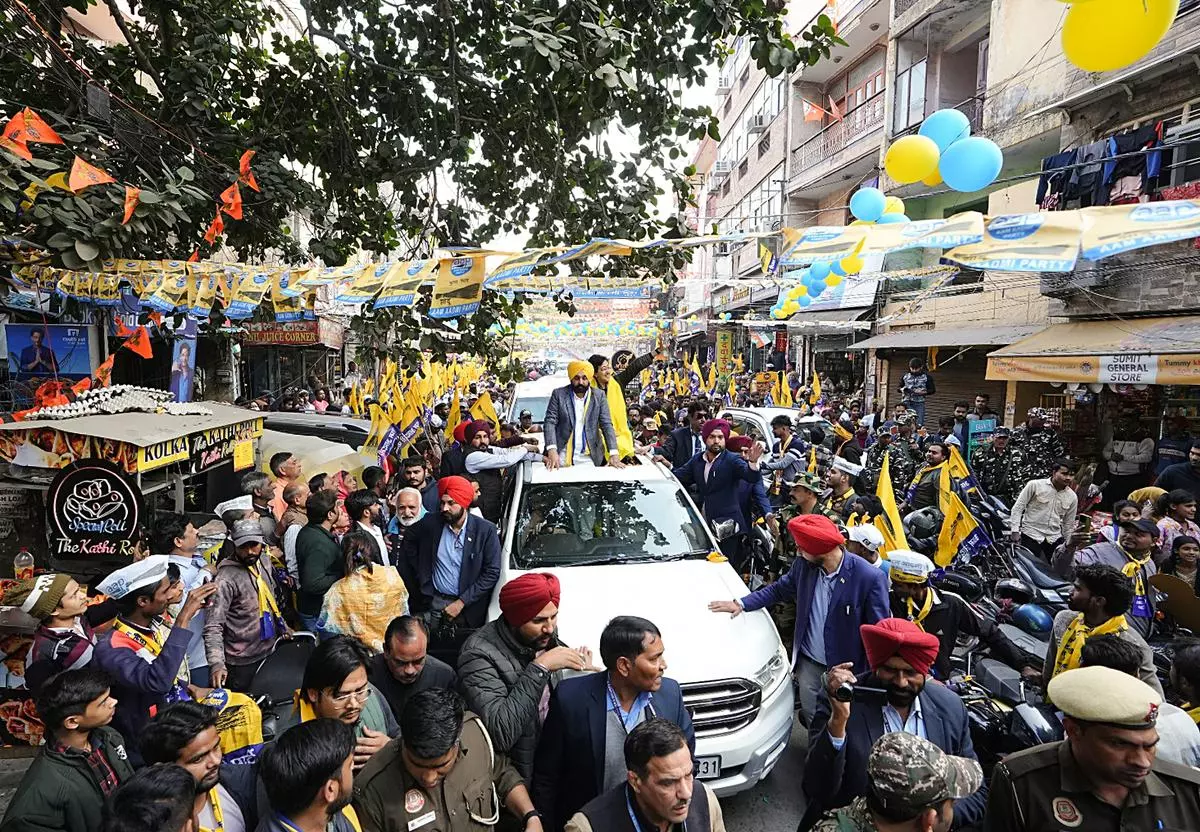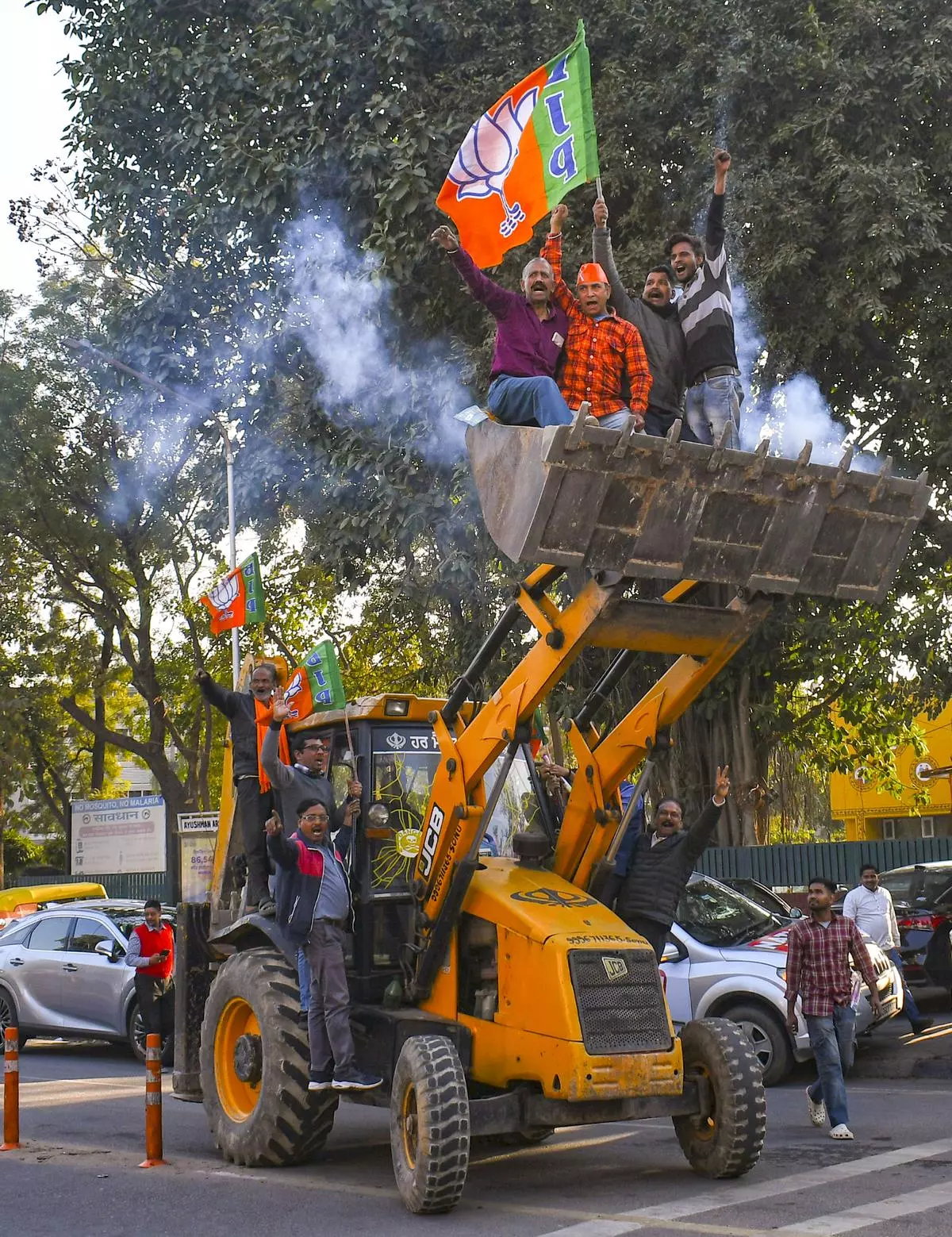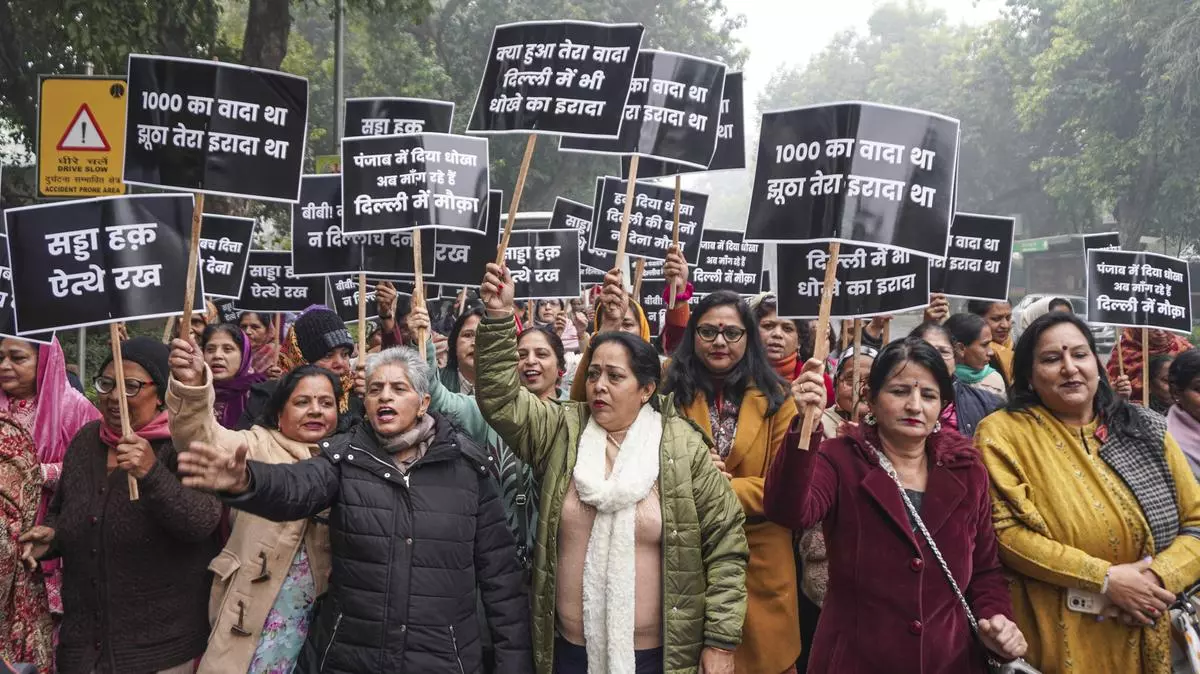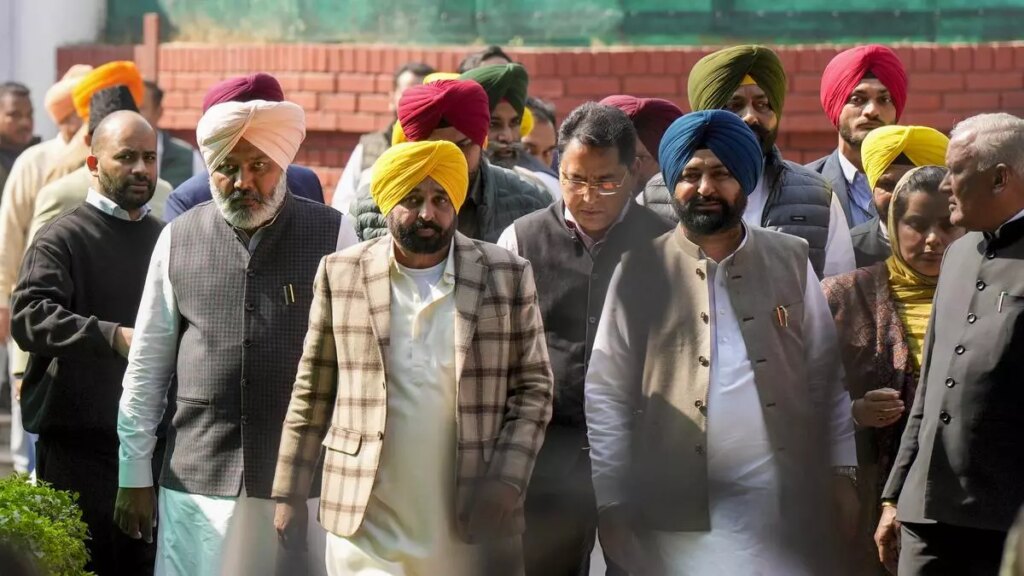The fall of the Aam Aadmi Party (AAP) in the Delhi Assembly election has sent shock waves through Punjab, the only State where the party currently holds power. The AAP’s defeat at the hands of the BJP has undoubtedly lifted the spirits of both the Congress and Shiromani Akali Dal (Badal), two key players in the Sikh-majority border State. This is despite the fact that the Congress failed to secure a single seat in the Delhi Assembly election for the third consecutive time, while SAD (Badal) chose not to field any candidates in the national capital this time round.
The Delhi results have certainly added a new layer of intrigue to Punjab politics as these parties gear up for future battles. Following the AAP’s crushing defeat, party convenor and former Delhi Chief Minister Arvind Kejriwal met with Punjab Chief Minister Bhagwant Mann, his Cabinet colleagues, and party MLAs in Delhi. The AAP claimed that the meeting was held to thank them for their efforts in the Delhi election and to discuss making Punjab a model State ahead of the 2027 Assembly election. However, critics viewed it as Kejriwal’s attempt to keep the besieged party intact in Punjab and reassert his influence over the State government after his own electoral loss in Delhi.
Perception problem
The Mann government has been grappling with a public perception problem, facing criticism that it lacks governance experience and it is being remotely controlled from Delhi. Also, in October 2024, the State government appointed Vibhav Kumar, Kejriwal’s former personal assistant, as Chief Advisor to Mann, which many observers said was done on Kejriwal’s recommendation.
Also Read | Unkept promises in Punjab haunt AAP in Delhi
Clearly, the AAP’s political future now hinges on its performance in Punjab. However, observers warned that any overt interference by the Delhi leadership in Mann’s government, or the continued diversion of State resources for the party’s campaigns outside Punjab, could prove counterproductive. Such actions risk alienating a region with deeply rooted sub-nationalist sentiments, potentially undermining Kejriwal and the AAP’s credibility in their sole stronghold.
Ashutosh Kumar, head of the political science department at Panjab University, said: “For the AAP, balancing central authority with regional autonomy will be critical to sustaining its influence in Punjab now, while ensuring it delivers a success story that can be leveraged in Punjab in the next election and elsewhere for political survival.”
Despite having been in power for three years, the AAP’s Punjab unit continues to be the victim of widespread disillusionment with other political parties in the State.
Observers have also criticised the AAP’s excessive reliance on its Punjab unit for campaign purposes elsewhere, arguing that it has disrupted daily governance in the State. Following the party’s setback in Delhi, the Mann-led government convened a Cabinet meeting after a gap of over four months—a delay attributed to the Chief Minister and his Cabinet colleagues campaigning extensively for the party in Delhi and Haryana.
Controlling Punjab from Delhi
The AAP’s recent Delhi meeting has also cemented public perception in Punjab that that the party’s central leadership is seeking to exert greater control over the Mann government. Ashutosh Kumar said: “It is being argued that the meeting, held in Delhi at the expense of Punjab’s exchequer, could have easily been conducted via video conference. Such moves risk fuelling scepticism among Punjab’s electorate, who are already wary of external interference in the State’s governance.”

Punjab Chief Minister Bhagwant Mann takes part in a roadshow in support of Atishi, the AAP candidate in the Kalkaji Assembly constituency, in New Delhi on January 30.
| Photo Credit:
ANI
Jagtar Singh, a Chandigarh-based political commentator and author, claimed that during the meeting, Kejriwal instructed MLAs from Punjab to approach him directly if bureaucrats failed to comply with their directives. He said: “This undermines the authority of the Chief Minister and signals the creation of a parallel power centre. It raises genuine concerns about external interference in State affairs.”
Some analysts also believe that the recent turn of events presents an opportunity for Mann to step out of Kejriwal’s shadow and establish himself as a leader in his own right, with genuine political agency. Harjeshwar Singh, a political analyst who teaches history at Sri Guru Gobind Singh College, Chandigarh, said: “How Bhagwant Mann navigates through fresh challenges posed by a weakened Kejriwal is to be seen as he, in all likelihood, will be receiving back-end support from BJP, which would like to decimate his rival.”
The AAP burst onto the national stage in 2013 when it secured power in Delhi after positioning itself as a party with a difference. It charged rival parties as serving as havens for opportunistic turncoats while portraying its leaders as dedicated workers committed to cleansing politics in the country. However, the party’s image has faced significant erosion, with as many as eight outgoing AAP MLAs defecting to the BJP after they were denied tickets for the Assembly election. These defectors have accused the AAP of being “plagued by corruption” and deviating from its “original ideology”.
Congress, BJP keen to weaken AAP
According to Ashutosh Kumar, the AAP’s electoral defeat in Delhi has cast doubts on its ability to deliver on its promise of alternative politics in Punjab. He said: “Once a party that championed anti-corruption, the end of VIP culture, and governance at people’s doorsteps, the AAP now risks being perceived as just another political entity.”
He added: “Both the Congress and the BJP have found common ground in their efforts to weaken the AAP. For the BJP, in particular, eliminating a competitor that resonates with the lower and middle classes while offering a milder version of Hindutva is a strategic priority.”
Congress leader Partap Singh Bajwa, who is the Leader of the Opposition in the Punjab Assembly, has claimed that Mann might follow the example of Eknath Shinde in Maharashtra. He has predicted an imminent split in the AAP Punjab unit, which has 94 seats in the 117-member Assembly. However, Mann himself has rubbished such claims. Political observers have also ruled out such a possibility in the near future.
In the Punjab Assembly, the Congress has 16 members, while the BJP has only two. SAD (Badal) has three members, while one MLA belongs to the Bahujan Samaj Party (BSP). There is also one independent MLA.
However, Ashutosh Kumar noted that while the AAP-led government faces no immediate threat, internal dissent could see some leaders break away. He said: “The Mann government’s struggles—tackling drugs, redressing farm distress, dismantling the sand mafia, and curbing corruption—echo the AAP’s challenges. Unmet promises, including direct financial aid to women, coupled with rising subsidies, have only exacerbated Punjab’s mounting debt.”

BJP workers in Punjab celebrate their party’s win in the Delhi Assembly election, in Chandigarh on February 8.
| Photo Credit:
PTI
He added that concerns about increased interference from the Delhi-based AAP leadership may be unfounded, as the State unit’s autonomy is likely to grow after the Delhi election outcome. “Any attempt by a desperate high command to overstep would backfire, as regionalism plays a key role in Punjab’s identity politics.”
After the BJP’s resounding victory in Delhi, Punjab BJP chief Sunil Jakhar and Union Minister Ravneet Singh Bittu stated that Prime Minister Narendra Modi will have to take up the task of making Punjab AAP-free.
How BJP might grow
In the 2024 Lok Sabha election, the BJP went alone in Punjab after parting ways with SAD. Despite the year-long farmers’ agitation, it improved its electoral performance, securing 18 per cent of the vote. It finished as runner-up in three constituencies. “Now the BJP will likely seek more opportunities to mobilise radical Hindu elements, especially in urban areas,” Kumar said. “The Congress is well-positioned, with a solid support base among Hindus and Sikhs. As the AAP declines, both the Congress and the BJP stand to gain in the State.”
The victory of BJP candidate Manjinder Singh Sirsa in Delhi’s Rajouri Garden seat marks a significant shift in Sikh political dynamics, as the saffron party steadily occupies ground once held by SAD (Badal).
Sirsa, a former SAD (Badal) leader and ex-president of the Delhi Sikh Gurdwara Management Committee (DSGMC), complements the BJP’s ambitious plans for Punjab, where it has been working hard to project itself as a pro-Sikh force.
A key aide of SAD leader Sukhbir Badal, he had quit the party in 2021 ahead of the Punjab Assembly election.
Harmeet Singh celebrated Sirsa’s success on Instagram and attributed it to the “unwavering support and trust” of the people in the BJP’s vision for development and governance.
The BJP’s decision to bring Manjinder Singh Sirsa into Chief Minister Rekha Gupta’s Delhi Cabinet goes beyond mere representation. It is a strategic move aimed at Punjab, according to political analysts.
SAD state of affairs
Singh himself had resigned from SAD’s Delhi unit just a week after his election as DSGMC president in 2022. Sirsa’s win adds to the list of successes for BJP Sikh candidates in Delhi, including Tarvinder Singh Marwah and Arvinder Singh Lovely.
SAD has been battling erosion of voter base on one hand and loss of key leaders on the other. Citing the examples of Delhi, Patna, Nanded, and Haryana, Sukhbir Badal has also accused the Rashtriya Swayamsevak Sangh (RSS) of taking control of Sikh shrines and bodies to strengthen the BJP and weaken SAD (Badal).

Women from Punjab stage a protest outside Kejriwal’s residence in New Delhi on January 4, complaining that the AAP government in Punjab has failed to fulfil the promise of a monthly stipend for women.
| Photo Credit:
PTI
Jagtar Singh said: “SAD, once a dominant force in Punjab politics, has been marginalised, leaving a political vacuum. Who fills that space will shape the broader political scenario leading up to the 2027 election.”
He added: “In Punjab, the BJP cannot be assessed the same way as in States like Uttar Pradesh or Delhi. Neither the Jan Sangh nor its successor, the BJP, has ever held a dominant position in Punjab’s politics. Since 1967, it has largely contested elections in alliance with the Akali Dal, except in 1992, when the Akalis sat out. Now, the BJP is testing the waters on its own. It can certainly expand, but it is unlikely to dominate the larger political space.”
Also Read | Will the rise of Waris Punjab De reignite radical politics in Punjab?
The AAP-led government in Punjab has come under scrutiny for its handling of the State’s financial challenges, facing allegations of securing high-interest loans, reckless spending, and amending property tax laws amid mounting debt.
Whither “Punjab model”?
Jagtar Singh said: “After the Delhi debacle, the AAP must rethink its strategy. Freebies alone won’t guarantee victory in Punjab, where political dynamics are distinct. The party has yet to grasp this. It led to its heavy defeat in the 2024 Lok Sabha election, in which it could win just three of 13 seats.”
After his meeting with Kejriwal in Delhi, Mann told mediapersons that his government’s priorities remain focused on education, healthcare, electricity, and water. However, his remarks appeared disconnected from several broader challenges facing the State. “Our government in Punjab has already exceeded its commitments,” he asserted, highlighting initiatives like the closure of 17 toll plazas and the abolition of multiple pensions for MLAs.
Despite the AAP’s much-celebrated “Delhi model” of governance, it could not come back to power after two full terms. Now, the pressing question for the party is whether it can script a success story in a full-fledged State by crafting a compelling “Punjab model” ahead of the 2027 Assembly election.
Source:https://frontline.thehindu.com/politics/punjab-elections-aap-crisis-bhagwant-mann-arvind-kejriwal-bjp-congress/article69234257.ece

